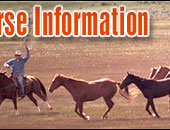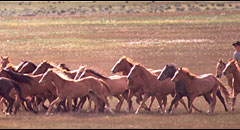 |
   |
|
|
|
You are here: Horses > Horse pasture / forage > Intensive grazing |
Increase Grazing Through Pasture Management
Did you know that you can double the mount of grazing your horse will enjoy in
your pasture with little expense? If you are well versed with the way horses
graze, you can make the process work for you. |
|
|
Generally speaking, horses will first look for the best
plants and eat them from the top down. As they do so, they
can graze down pretty close to the ground, which is not good
for your pasture. Also, their unwillingness to eat
undesirable weeds and unhealthy plants will lead to these
plants having an opportunity to go to seed and propagate,
while the healthy plants are not given this opportunity.
Ironically, your fertilizing the ground frequently will help
the weeds and unhealthy plants to establish themselves while
choking out the more desirable plants.
|
Rotational grazing is therefore a clearly indicated method of pasture
management. Keeping in mind that for every 1,100 pounds of mature horseflesh you
will need to have two acres of pasture, you can do he math and subdivide your
pasture with fencing and rotate the animals ever two to three weeks to permit
the healthy and desirable plants to re-grow while permitting you the opportunity
to do some weed management. Yet lately experts have found a way to reduce the
area required by one acre, if you aggressively manage your pasture. This means
that you allow your horse to intensively graze and area, then lime it and also
fertilize it you will be able to shave off the spatial requirements. Other tests
have shown that by following this rotational regimen you will be able to add
about two or three weeks of grazing time for your animals!
As you may know, rotational grazing – as opposed to continuous grazing – is a
proven tool in cattle farming, and farmers have reported that they are reaping
financial benefits from implementing this procedure on their acreages. Granted,
for the horse owner this means spending a bit more time on the pasture to
monitor the overall health of their acres, but the results show that this is an
endeavor that is well worth the time. While it is true that those with an
overflowing personal schedule might be hesitant to sign on to this idea,
consider that intensive grazing does not have to be complicated.
At the onset you need to become familiar with the types of grasses planted in
your pasture. As you limit the grazing area and get ready to change it, mow it
down to permit for a uniform re-growth of healthy plants. Only graze one paddock
for about one to three days and then move your animals. To create paddocks, you
can simply use the temporarily electric fending that is readily available at
hardware stores. Farm stores carry the fancier brands, and while the price tags
may be a bit higher the ease of handling is also greatly increased. During the
summer you can remove the paddocks. Be sure to drag the pasture to get rid of
clumped manure which harbors parasites. For those who own both cattle and
horses, you will need to ensure that your cattle graze after the horses because
in general cattle will eat the plants that horses will not enjoy.
 |
Read the next horse pasture article on Grazing Grasses Good for Your Horse. |
|
|
|
|
 |
|
|
|
|
|
Horse Education
|
|
|
|
|
Horse Information Topics
|
|
|
|
|
|
|
|
Horse Business Owners
|
| |
Advertise with Us
Have your horse products or services exposed to over 27,000 of our monthly visitors.
|
|
|
|
|
|